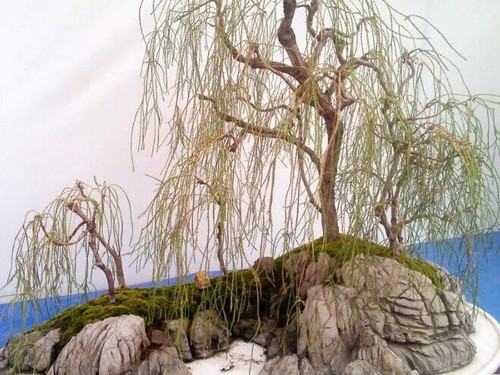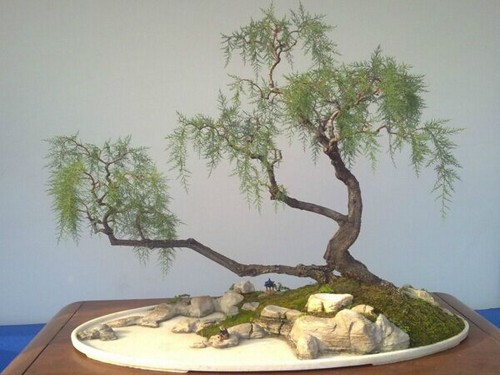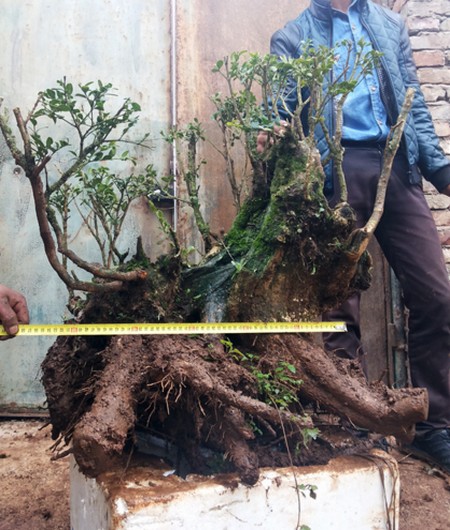Making weeping willow bonsai with strange willow
Tamarix, a Guanyin willow, a Xihe willow. The stem is not very big, the red stem is weak, and the leaves are as thin as strands, graceful and lovely. Make flowers three times a year, the spike is two or three inches long, its color is pink and shaped like a polygonum flower, so it is also known as Sanchun willow. Its flowers bloom in case of rain, it is appropriate to plant waterside ponds, if the day will rain, Tamarix will rise first to respond to it, also known as the rain master. Leaves are red in autumn, but do not fall with frost, and cuttings are easy to live in spring.

Willow branches drooping, swaying with the wind, is a very poetic plant, countless poems about willow in previous dynasties. Many people also want to use bonsai as an art form to express the graceful elegant demeanor of weeping willow, but because of the long branches and large leaves of willow in nature, the effect of making bonsai with it is not ideal. As a result, some bonsai artists use other trees with small leaves, branches that can droop naturally or after artificial processing to replace willows to make weeping willow bonsai. Commonly used are Chinese wolfberry, June snow, lobular privet, Yingchun, Tamarix and other tree species. Among them, Tamarix has the best artistic effect.
Let's take Tamarix as an example to talk about the production of weeping willow bonsai.
Most willows in nature grow in plain areas or riverside lakesides where there is plenty of soil moisture, so the roots or trunk of willows are not as rugged and vigorous as trees growing on mountains, and there are no stone-attached, cliff-like forms that are not common in nature. Therefore, these factors should be taken into account when selecting tree stumps to make the bonsai accord with the laws of nature and achieve the artistic effect of "originating from nature and higher than nature".
The stump survived by billet cultivation can be modeled when the branches are not lignified and the flexibility is the best from May to June, and its form can adopt direct dry type, oblique dry type, facing water type, wind type, horizontal dry type, double dry type and so on according to the different stumps. Methods the branch can be wound and tied with wire to make it droop; it can also be wound around a circle of wire on the flowerpot, and then the branches can be staggered and fixed on the metal ring, which can be made to droop by pulling; it can also hang heavy objects with different weights on the branches and make them droop by the action of gravity.
In addition, when the branch is not lignified, the external force can be applied by fingers from the base to the tip of the branch to make the branch bend and sag. This method should be carried out repeatedly and increase the pressure while bending. Others select one or more bending points in the middle and upper part of the branch and gently break it by hand to make the branch bend and droop. After this method, the broken branch is strong and powerful, while the new branch turns smoothly, and the whole work combines strength and softness. The effect is unique. The above methods can be used either alone or comprehensively. No matter what kind of method, there should be a natural transition from the base of the tree to the trunk, main branches, side branches and twigs.
The production of other tree species imitating weeping willow bonsai is more or less the same as that of Tamarix, which can be made according to the different characteristics and habits of each tree species.
The shaping of Tamarix bonsai should be carried out in spring, and must not be pruned in winter, otherwise it will cause "retrenchment" and make a complete bonsai lose the necessary leaves and branches, causing regret and seriously affecting the ornamental. During the growing period, the Tamarix bonsai is maintained in the semi-shade of ventilation to keep the potted soil and air moist, so as to avoid yellowing and shedding of leaves due to drought, and long-term stagnant water in the basin soil will cause root rot.
Under the condition of ensuring that the basin soil does not accumulate water, it is often sprayed to the plant, which is very beneficial to its growth. Its leaves are green, the new branches are soft and charming, and they are very beautiful. Apply mature thin liquid fertilizer every 7 to 10 days to provide sufficient nutrients to make the plant grow vigorously; the fertilizer liquid should be light and not thick, otherwise it will make the branches and leaves grow and affect the ornamental.
Tamarix grows rapidly and has strong germinating ability. in order to maintain the beauty of the tree shape, the branches that affect the shape can be cut off at any time during the growing period. Keep the basin soil free from freezing and dryness in winter, and the south of the Yellow River can also spend the winter in the outdoor shelter from the wind and sun, keeping the soil slightly moist to prevent branch retreat caused by "dry freezing" and even death of the whole plant in serious cases. Turning the basin once every spring, the basin soil can be mixed with 1 part of sand soil and 1 part of garden soil, and the effect is better if it is poured with rotten liquid fertilizer several times or mixed with a small amount of plant ash.
Time: 2019-05-26 Click:
- Prev

The making method of strange willow bonsai
Tamarix branches are small, drooping, graceful, shaped like weeping willows; its torso is like iron, old and strange, with the quality of pine and cypress; it blossoms three times a year, the flowering period is longer, and the pink flowers are more enchanting; its roots, such as swimming dragons, are wonderful in shape, whether they are root, trunk, leaves or flowers.
- Next

Matters needing attention in making bonsai with downhill pile
What do you mean by going down the hill? It means that the plants originally grown in the mountains are artificially transplanted to similar man-made environments. So what should be paid attention to in the process of making downhill pile bonsai? Downhill pile bonsai production points for attention: 1. Do not be blind to the pile. Many people always want to have a lot of bonsai, which can be watched at any time.
Related
- Fuxing push coffee new agricultural production and marketing class: lack of small-scale processing plants
- Jujube rice field leisure farm deep ploughing Yilan for five years to create a space for organic food and play
- Nongyu Farm-A trial of organic papaya for brave women with advanced technology
- Four points for attention in the prevention and control of diseases and insect pests of edible fungi
- How to add nutrient solution to Edible Fungi
- Is there any good way to control edible fungus mites?
- Open Inoculation Technology of Edible Fungi
- Is there any clever way to use fertilizer for edible fungus in winter?
- What agents are used to kill the pathogens of edible fungi in the mushroom shed?
- Rapid drying of Edible Fungi

